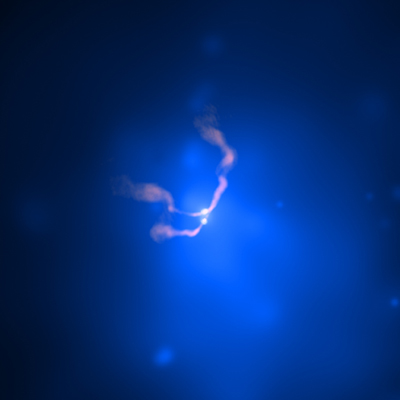Any guesses as to what the most powerful event in the universe is? According to a team of NASA scientists working with breakthrough computer modeling techniques, it’s the merger of two massive black holes. When the event occurs, gravitational waves muscle out from the collision site at the speed of light. Each such merger generates more energy than all the stars in the universe combined. John Baker at Goddard Space Flight Center is lead author of the paper, which appears in the March 26 issue of Physical Review Letters.
Of course, although the modeling works (via the largest astrophysics calculations ever performed on a NASA supercomputer), one problem is that gravitational waves have yet to be detected directly. But there is reasonable expectation that that will change through observations from the Laser Interferometer Gravitational-Wave Observatory and the joint NASA/ESA Laser Interferometer Space Antenna, a proposed mission that should be able to do the job. Einstein’s theory of general relativity predicts that a massive black hole merger would cause spacetime itself to jiggle, in the words of a NASA news release, “…like a bowl of Jell-O.”
Image: Scientists are watching two supermassive black holes spiral towards each other near the center of a galaxy cluster named Abell 400. Shown in this X-ray/radio composite image are the multi-million degree radio jets emanating from the black holes. Click on image to view large resolution. Credit: X-ray: NASA/CXC/AIfA/D.Hudson & T.Reiprich et al.; Radio: NRAO/VLA/NRL
Also on the black hole front is a new study using Chandra data that shows most of the energy released by matter as it falls toward a supermassive black hole appears in the form of high-energy jets traveling away from the object at speeds near that of light. So powerful are these jets that they could disrupt gas clouds that might otherwise cool into new stars.
“We see enough energy coming out of these black holes to completely stifle star formation,” said study co-author Christopher Reynolds of the University of Maryland. “This is an exciting finding because it demonstrates a direct interaction between black holes and galaxy formation, which is a hot topic in astrophysics right now.”
Performed by scientists at the University of Maryland, Stanford University, the University of Cambridge and New Mexico State University, the study will appear in an upcoming issue of the Monthly Notices of the Royal Astronomical Society. So much for old, ‘boring’ black holes, the kind that receive short shrift next to the more crowd-pleasing quasars. This work is a window into galaxy formation in the presence of black holes, another reminder (when we’re not talking about dark matter) of how much we have to learn about how the largest objects in the universe take shape.



Monster Black Holes Soon to Collide?
Imagine a binary system consisting of two monstrous black holes locked in a tight orbital embrace. One of the beasts contains an astonishing 100 million times the mass of our Sun, outweighing the Milky Way’s central black hole by a factor of 25. But compared to its master, it’s a pipsqueak — a pathetic excuse for a black hole.
Active galaxy OJ 287 in Cancer is thought to have two supermassive black holes in its nucleus, one of them possibly the most massive such object known in the universe. In the model pictured here, flares occur when the smaller black hole plunges through a disk of gas around the larger one twice during each 12-year orbit.
S&T: Gregg DindermanThe primary black hole contains 17 or 18 billion solar masses, making it the heaviest single object known to science.
An international team led by Mauri J. Valtonen (University of Turku, Finland) not only claims that such a system exists, but that the team has measured a decay in the period of the binary’s 12-year, highly elongated orbit. As Valtonen and his colleagues reported at last week’s American Astronomical Society meeting in Austin, Texas, the two black holes are drawing slowly but inexorably nearer during each orbital passage as they radiate gravitational waves, ripples in the fabric of space-time predicted by Einstein’s general theory of relativity.
If their analysis is correct, the system, located in the active galaxy OJ 287, contains one of the most massive black holes in the universe and is the most extreme binary system ever discovered. Moreover, OJ 287 presents scientists with an extraordinary opportunity to test Einstein’s greatest theory in the strongest gravitational fields the universe has to offer.
Full article here:
http://www.skyandtelescope.com/news/home/13731992.html
ADVANCED LIGO PROJECT FUNDED BY NSF (TOP STORIES)
The Advanced LIGO Project, an upgrade in sensitivity for LIGO (Laser
Interferometer Gravitational-wave Observatories), was approved by
the National Science Board in its meeting on March 27. The National
Science Foundation will fund the $205.12 million, seven-year
project, starting with $32.75 million in 2008. This major upgrade
will increase the sensitivity of the LIGO instruments by a factor of
10, giving a one thousand-fold increase in the number of
astrophysical candidates for gravitational wave signals. “We
anticipate that this new instrument will see gravitational wave
sources possibly on a daily basis, with excellent signal strengths,
allowing details of the waveforms to be observed and compared with
theories of neutron stars, black holes, and other astrophysical
objects moving near the speed of light,” says Caltech’s Jay Marx,
executive director of the LIGO Laboratory.
Details: http://sulaco.caltech.edu/emp/Media/Press_Releases/PR13123.html
LIGO OBSERVATIONS PROBE THE DYNAMICS OF THE CRAB PULSAR (ASTRONOMY)
The search for gravitational waves has revealed new information
about the core of one of the most famous objects in the sky: the
Crab Pulsar in the Crab Nebula. An analysis by the international
LIGO (Laser Interferometer Gravitational-Wave Observatory)
Scientific Collaboration to be submitted to Astrophysical Journal
Letters has shown that no more than 4 percent of the energy loss of
the pulsar is caused by the emission of gravitational waves.
Details: http://mr.caltech.edu/media/Press_Releases/PR13154.html